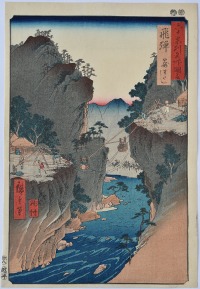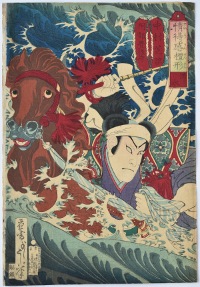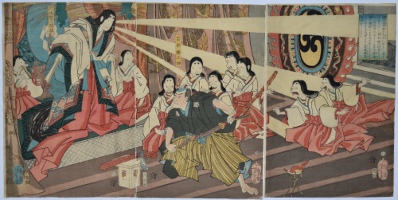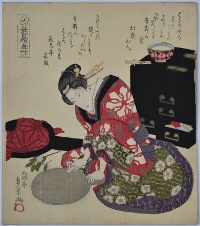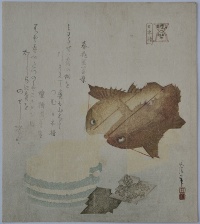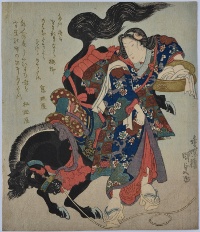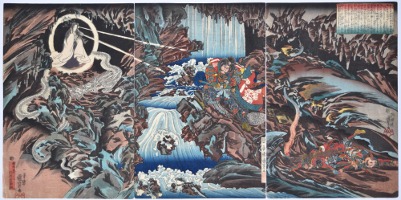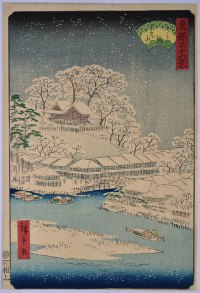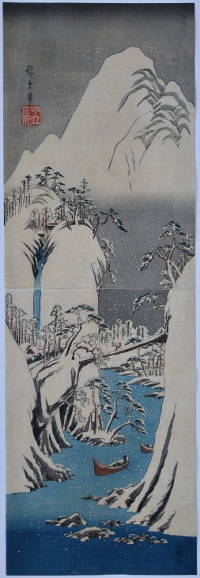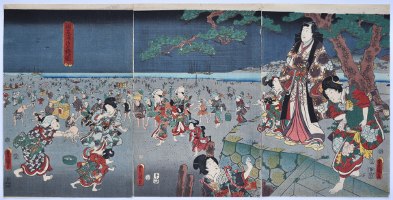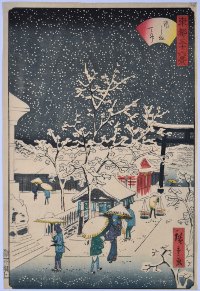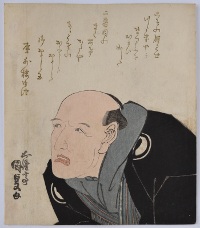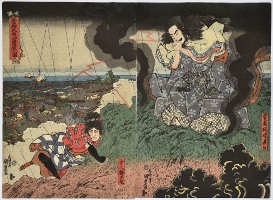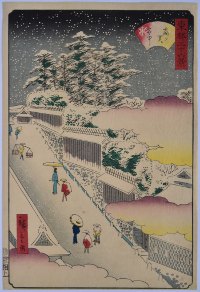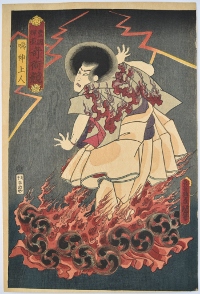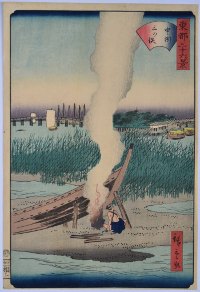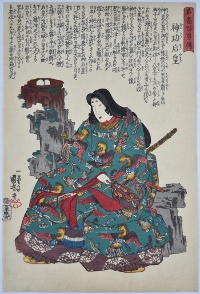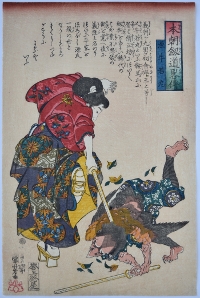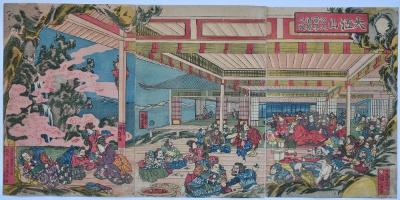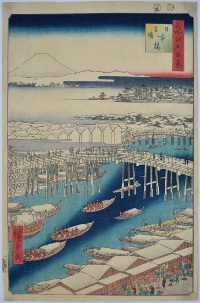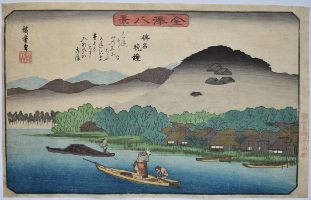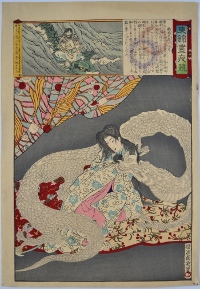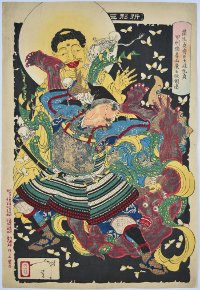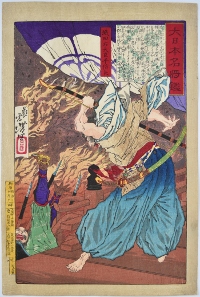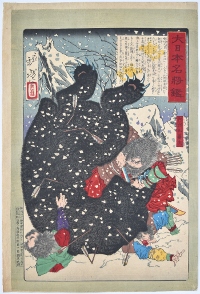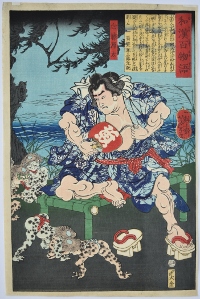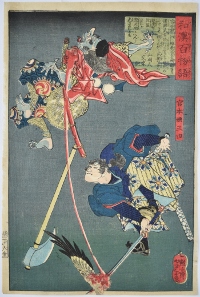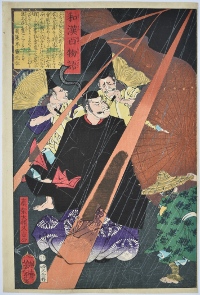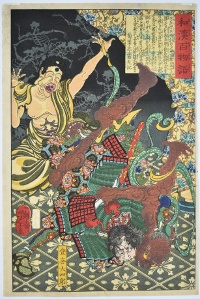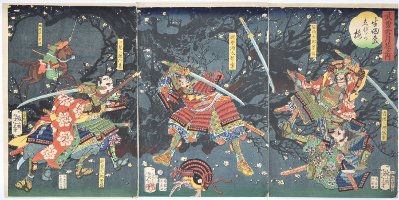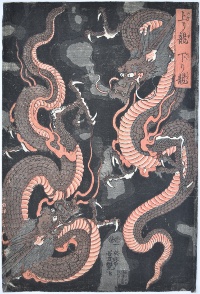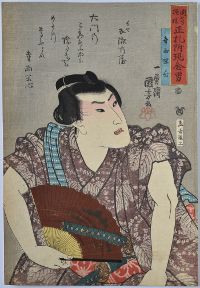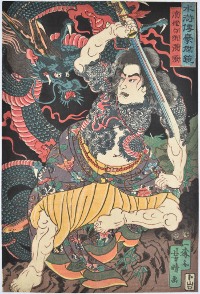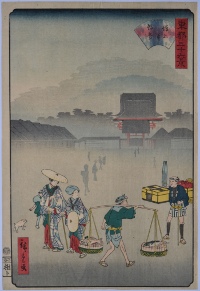Ichiryusai HIROSHIGE (1797-1858)
Click here to view image full size.
Hida. Kago-watashi, “The Basket Ferry, Hida Province” from Rokuju yoshu meisho zue, “Famous Places in the Sixty-Odd Provinces.” The set published by Koshimuraya Heisuke between 7/1853 and 3/1856 ( this being 1853 ).
Extremely fine impression of the first edition. Fine colour and condition. Signed Hiroshige ga.
Status: Sold
Tsukioka YOSHITOSHI (1839-1892)
Click here to view image full size.
Flood from a series Seiu kandankei, “A Barometer of Emotions.” Shows the actor Nakamura Shikan IV as Abe Bungo no Kami riding through rough waves. A fine set published by Okura Magobei, 1876.
Very good impression and colour. Slight edge soil, otherwise very good condition. Signed Oju Yoshitoshi hitsu.
Status: Sold
Ichiryusai HIROSHIGE (1797-1858)
Click here to view image full size.
A distant view of Mount Daisen [ Oyama ] in Hoki Province. One of the best designs from Rokuju yoshu meisho zue, “Famous Places in the Sixty-Odd Provinces.” The set published by Koshimuraya Heisuke between 7/1853 and 3/1856 ( this being 12/1853 ). White rain ( printed with gofun ) falls on groups of peasants planting rice. A lovely design, the edges of the paddy fields zig-zagging into the distance. This is the rare first edition with blue and yellow diagonal bands on the sub-cartouche.
Fine impression with strong woodgrain showing. The second state of the first edition has the rain printed black (not using gofun as here).Very good colour and condition. Signed Hiroshige ga.
Status: Sold
Tsukioka YOSHITOSHI (1839-1892)
Click here to view image full size.
A triptych showing the exorcism of the evil fox of Princess Osakabe by Miyamoto Musashi. The story relates how Musashi is the only warrior brave enough to enter Himeji castle which is haunted by the princess. He pursues her and finally cannot resist touching her which exorcises the evil foxes who can be seen surrounding the princess. In gratitude she presents him with a sword (seen here on middle and left sheet). Published 1863 by Yamazakiya Seishichi.
Very good impression and colour. Slight creasing, otherwise good condition. Signed Ikkaisai Yoshitoshi ga.
Status: Sold
Utagawa SADAKAGE (active c. 1818-1844)
Click here to view image full size.
A surimono, Kinsei, “Metal” from Gobantsuzuki, “A Set of Five” surimono based on the five elements: Wood, Fire, Earth, Metal and Water. Shows a woman polishing a metal mirror. Published c. mid-1820s. The set was designed for a group led by the poet Shakuyakutei whose plum-blossom emblem is seen at the top of the title cartouche.
Superb impression, colour and condition. Extensive silver and gold. Mint condition. Signed Gokotei Sadakage ga.
Status: Sold
Hotei GOSEI (Active c. 1804-1835)
Click here to view image full size.
A surimono showing a still life of fish and utensils from a fine and rare set Toto meisho awase, “Famous Attractions of the Eastern Capital.” The series title in a cartouche in the shape of the character “go” representing the Go-gawa Club. Each surimono shows something related to the location in Edo, in this case the sub-title is Nihonbashi. What the connection is is not obvious to me; perhaps the fish were a delicacy in restaurants which crowded round the bridge. Gosei was a pupil of Hokusai who gave him the name Hokuga which he changed to Gosei around 1810. Published c. 1820. Possibly the only known impression.
Very good impression and colour. Some slight soil, otherwise good condition. Signed Gosei hitsu.
Status: Sold
Utagawa KUNISADA (1786-1864)
Click here to view image full size.
A surimono showing the strong woman of Omi, Okane, stopping a runaway horse from a temple by holding its tether down with her geta. Published for the year of the Horse, 1834.
Fine impression and colour. Areas of gold and silver. Some slight crinkling, otherwise very good condition. Signed Kochoro Kunisada ga.
Status: Sold
Utagawa KUNIYOSHI (1798 – 1861)
Click here to view image full size.
Nitta Tadatsune encountering the goddess of Mount Fuji and her dragon in a cavern with numerous stalactites and a fast flowing river and waterfall. Published by Tsuji-ya Yasubei c 1844. Robinson T143.
Very fine impression. Fine colour and condition. Signed Ichiyusai Kuniyoshi ga.
Status: Sold
Ichiyusai HIROSHIGE II (1829-1869)
Click here to view image full size.
A snow scene: Imadobashi Matsuchiyama, “Imado Bridge and Matsuchi Hill.” From Toto sanjurokkei, “Thirty-six Views of the Eastern [ Edo ] Capital.” The set published by Ai-To between 1861 and 1862 ( this being 8/1862 ). This was also a district that attracted Hiroshige I and he designed a number of prints of the area. One of the six best designs from the set.
Fine impression of the first edition. Fine colour. Trimmed close at bottom, otherwise fine condition. Signed Hiroshige ga.
Status: Sold
Ichiryusai HIROSHIGE (1797-1858)
A vertical oban diptych, Fujigawa no setchu, “The Fuji River in Winter.” Hiroshige records in his diaries that he commenced on a journey westwards from Edo on the fourth month Tempo 12 (1842). He walked the Koshukaido to Kofu in Kai Province and then on to Shimo-suwa. On the route to Kofu, he mentions visiting the Saruhashi, Monkey Bridge, and consequently must have crossed the upper reaches of the Fuji River to reach Kofu. On his return Hiroshige designed two kakemono-e, one of the Monkey Bridge for the publisher Tsutaya, and the design here of Fujigawa for the publisher Kikakudo (Sanoya Kihei). Both are considered masterpieces. The magisterial format perfectly conveys the wild landscape with a diminutive figure crossing the bridge above the gorge with boatmen on the river. Published c. 1842-44. There are many copies of these two kakemono-e. Genuine impressions of this design should have a small vertical block defect bottom right where the mountain meets the river, just to the left of the publisher’s seal. Extremely rare.
Fine impression. The slopes of the mountain top left are printed without outline and appear different on different impressions, also because the block for the sky was changed. Fine colour (although the colour scheme is almost monochromatic relieved by only the blue of the river and touches of brown and green). Very good condition: Full size with ample room for joining of the two sheets. These designs often come heavily browned as they were hung as substitute paintings. Signed Hiroshige hitsu.
Status: Sold
Utagawa KUNISADA (1786-1865)
Click here to view image full size.
A triptych showing Prince Genji (far right) on a stone terrace looking out at Suma Beach, Akashi, thronged with visitors enjoying themselves. Two of his party look as though they are going to collect shells. A mitate of Chapter XIII of the Genji Monogatari where Genji is exiled at Akashi, Akashi no ura shiogari no zu. There was a proliferation of sets based on the original Genji Monogatari and the Ryutei Tenehiko (1783-1842) update at this time. Published by Yamaguchiya Tobei, 1/1855.
Fine impression and colour. Bokashi on the edge of the bay at top (missing on later editions). Fine condition. Signed Toyokuni ga.
Status: Sold
Ichiyusai HIROSHIGE II (1829-1869)
Click here to view image full size.
Heavy snow, Yushima Tenjin, “Yushima Tenjin Shrine.” From Toto sanjurokkei, “Thirty-six Views of the Eastern [ Edo ] Capital.” The set published by Ai-To between 1861 and 1862 ( this being 9/1862 ). The shrine is famous for its ume, Japanese apricot trees, and the Ume Matsuri festival held in February and March. One of the six best designs from the set.
Fine impression of the first edition. Fine colour. Trimmed close at bottom, otherwise fine condition. Signed Hiroshige ga.
Status: Sold
Utagawa KUNISADA (1786-1865)
Click here to view image full size.
An extremely rare and unusual surimono: I have only seen two impressions – both of which have passed through my hands, and one of which was gifted to the Rijksmuseum, Amsterdam. Shows the most famous playwright of his age – Tsuruya Nanboku IV (1755-1829). His crest is clearly visible on his shoulder. He died on the 27th of the 11th month, 1829 and this surimono must date from shortly after that: A sort of shini-e – very unusual in surimono form. He wrote the most famous Kabuki ghost story: Yotsuya kaidan, “Yotsuya Ghost Story” (1825) as well as the quick-change play Osome no nanayuki (1813).
Fine impression and colour. The poems above printed in gold. Slight soil. Very small restored binding holes at left edge, and slight trimming at bottom. Signed Gototei Kunisada ga.
Status: Sold
Utagawa KUNISADA (1786-1865)
Click here to view image full size.
A rare diptych, Kansho Tempaizan mangan. This famous tale (with different versions) is the basis for the play Sugawara denju tenarai kagami, “Sugawara and the Secrets of Calligraphy” which was performed at the Kawarazaki Theatre, Edo, 9/1832. This Mt. Tempai scene shows Kan Shojo (Sugawara no Michizane), a Heian politician and poet, transforming himself into a demon and invoking a storm. Umeomaru , a former retainer of Kan Shojo is seen climbing the mountain on the left sheet. There is also a fine vertical surimono diptych of this subject issued by Kunisada in 1832. Published by Yamaguchi Tobei. A fine design I have not catalogued before.
Fine impression and colour. Imperceptible centre fold, otherwise fine condition. Signed Gototei Kunisada ga.
Status: Sold
Ichiyusai HIROSHIGE II (1829-1869)
Click here to view image full size.
Kasumigaseki setchu, “Kasumigaseki in Snow” from Toto sanjurokkei, “Thirty-six Views of the Eastern [ Edo ] Capital.” The set published by Ai-To between 1861 and 1862 ( this being 6/1862 ). Shows a steep incline in what is now the administrative district of Tokyo. One of the six best designs from the set.
Fine impression of the first edition. Fine colour. Trimmed close at bottom, otherwise fine condition. Signed Hiroshige ga.
Status: Sold
Utagawa KUNISADA (1786-1865)
Click here to view image full size.
Narukami Shonin, a wicked priest, from the play Narukami. One of a set Toyokuni kigo kijutsu kurabe, “A Contest of Magic Scenes by Toyokuni.” The series published by Hiranoya Shinzo, 1862. The set is known for its deluxe printing.
Superb impression and colour. Fine condition. Signed Kio Toyokuni hitsu (77 year’s old).
Status: Sold
Ichiyusai HIROSHIGE II (1829-1869)
Click here to view image full size.
Nakazu Mitsumata, “Mitsumata Middle Strand.” Shows the charring of a boat to preserve it on the eight-acre Nakazu Island. In the background Tsukudajima and Eitaibashi. From Toto sanjurokkei, “Thirty-six Views of the Eastern [ Edo ] Capital.” The set published by Ai-To between 1861 and 1862 ( this being 3/1862 ). Compare with the Kuniyoshi landscape of the same subject published by Yamaguchiya Tobei, 1834. One of the six best designs from the set.
Fine impression of the first edition. Fine colour. Trimmed close at bottom, otherwise fine condition. Signed Hiroshige ga.
Status: Sold
Utagawa KUNIYOSHI (1797-1861)
Click here to view image full size.
The Empress Jingo Kogo, sumptuously attired, sitting on a rock with two Imperial Jewels above her. She is supposed to have invaded Korea although there is some debate about this. From a set Meiko hyaku yu den, “Stories of a Hundred Heroes of High Renown.” The series published by Idzumi-ya Ichibei, 1843-44.
Very fine impression, colour and condition. Signed Ichiyusai Kuniyoshi ga.
Status: Sold
Utagawa KUNIYOSHI (1797-1861)
Click here to view image full size.
Kaidomaru felling a tengu during practise with wooden swords from a set Honcho kendo ryaku den, “Abridged Stories of our Country’s Swordsmanship.” The series published by Kadzusa-ya Iwazo, c. 1845-6.
Very fine impression, colour and condition. Signed Ichiyusai Kuniyoshi ga.
Status: Sold
Utagawa KUNIYOSHI (1797-1861)
Click here to view image full size.
An early triptych showing Shutendoji’s palace on Mount Oyeyama, Oyeyama Shotendoji shuzui no zu. Raiko (Minamoto no Yorimitsu) is charged by the Emperor Murakami with killing the evil Shutendoji who terrorizes the neighbourhood. He and his retainers infiltrate the castle and ply Shutendoji and his ogrish band with sake and dance for them. Eventually Shutendoji is so intoxicated he has to be carried to bed, whereupon Raiko and his followers attack and decapitate Shutendoji. This is the episode most depicted with the head flying through the air. Published by Daikokuya Heikichi, c. 1832. Robinson T21. Rare.
Fine impression, colour and condition. Signed Ichiyusai Kuniyoshi ga.
Status: Sold
Ichiryusai HIROSHIGE (1797-1858)
Click here to view image full size.
Nihonbashi yukibare, “The Nihon Bridge, Clear Weather after Snow.” From Meisho Edo hyakkei, the “One Hundred Views of Edo.” The set published between 1856 and 1858 (this being 1856) by Uoya Eikichi. The bridge was completed in 1603 and was originally called Edo Bridge. All points are measured from this bridge (similar to our Charing Cross).
Fine impression of the first edition. There are slight variants of the first with some having red bokashi on the lower clouds but lacking the subtle gradation on Fuji and lower roofs. And also some have mica on the lower roofs. Fine colour and condition. Signed Hiroshige ga.
Status: Sold
Ichiryusai HIROSHIGE (1797-1858)
Click here to view image full size.
Shomyoji-no bansho, “Vesper Bells at the Shomyoji Temple” from the rare early set Kanazawa hakkei, “Eight Views of Kanazawa.” The temple was built in 1258 by Hojo Sanetoki; the environs are seen on the right with boats in the foreground. The distant hills are printed without key-block outlines giving a painterly quality. These Eight View sets were inspired by the Eight Views of Xiaoxiang in China, first painted in the 11th century and then brought to Japan in the 14 – 15th centuries. Kanazawa is across Japan from Tokyo on the north coast on the Japan Sea. Published by Koshimuraya Heisuke, 1835-6.
Very good impression and colour. Slight margin soil and small expert repair to bottom left corner. Signed Hiroshige ga.
Status: Sold
Toyohara CHIKANOBU (1838-1912)
Click here to view image full size.
Princess Toyotama, the daughter of the Dragon King of the sea, gives birth to Ugayafuki Aezu by turning herself into a dragon. From a set of 50 prints Azuma nishiki chuya kurabe, “Edo Embroidery Pictures.” The series published by Kobayashi Tetsujiro, 1886.
Fine impression with extensive mica. Fine colour and condition. Signed Yoshu Chikanobu hitsu.
Status: Sold
Toyohara CHIKANOBU (1838-1912)
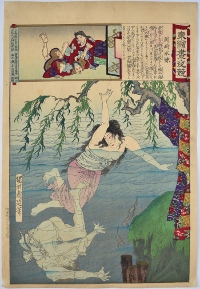
Click here to view image full size.
O’ai-no-kata of Okazaki dispatches a man who spied on her while taking a bath. From a set of 50 prints Azuma nishiki chuya kurabe, “Edo Embroidery Pictures.” The series published by Kobayashi Tetsujiro, 1886.
Fine impression, colour and condition. Signed Yoshu Chikanobu hitsu.
Status: Sold
Taiso YOSHITOSHI (1839-1892)
Click here to view image full size.
Toki Motosada, the retainer of Gamo Sadahide, throwing a red temple guardian to the ground and vanquishing the ghosts on Mount Inohana. From the set Shinkei sanjurokkaisen, “New Forms of Thirty-Six Ghosts.” The set published by Sasaki Toyokichi, 1889 – 1892 (this being 1890). This seems to be the same subject Yoshitoshi used for his set Wakan hyaku monogatari but the names are altered.
Very fine first edition, fine colour and condition. Signed Yoshitoshi.
Status: Sold
Tsukioka YOSHITOSHI (1839-1892)
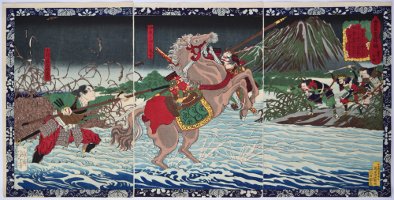
Click here to view image full size.
The battle of Fujikawa from a set of triptychs Toyotomi Shoshinroku published by Yorozumago, c 1869. The set relates Hideyoshi’s (1537-1598) exploits. From humble origins he became the second unifier of Japan who, after 100 years of war, brought stability and peace.
Fine impression, colour and condition. Full size with extra paper all around. Signed Ikkaisai Yoshitoshi hitsu.
Status: Sold
Taiso YOSHITOSHI (1839-1892)
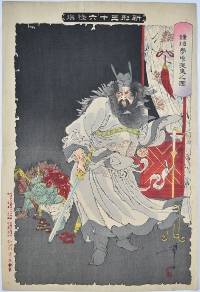
Click here to view image full size.
Shoki appearing in the Chinese emperor Ming Huang’s dream and cleansing him of a fever demon. From the set Shinkei sanjurokkaisen, “New Forms of Thirty-Six Ghosts.” The set published by Sasaki Toyokichi, 1889 – 1892 (this being 1890).
Very fine first edition, fine colour and condition. Signed Yoshitoshi.
Status: Sold
Taiso YOSHITOSHI (1839-1892)
Click here to view image full size.
The famous daimyo Oda Nobunaga throwing an assailant over a terrace while the Honnoji Temple burns behind him. Nobunaga’s branch of the Oda clan held control of central Japan but he was eventually killed by his treacherous vassal Akechi Mitsuhide at this temple in 1582. From a set Dai Nippon meisho kagami, “Mirror of Famous Commanders of Great Japan.” The series of 51 prints published by Kumagai and Funazu Chujiro, c. 1876 – 82. The design here by the latter in 1878.
Fine impression, colour and condition. Signed Oju Yoshitoshi hitsu.
Status: Sold
Taiso YOSHITOSHI (1839-1892)
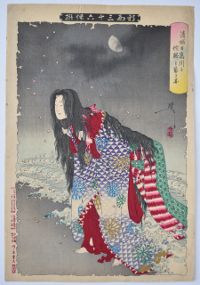
Click here to view image full size.
Shows Kiyohime changing into a serpent on the edge of the Hidaka River. The monk Anchin fell in love with Kiyohime only to change his mind. He escapes across the river followed by Kiyohime who becomes a serpent and traps him in the bell of the Dojo-ji Temple and kills him. From a set Shingata sanjurokkaisen, “New Forms of Thirty-six Ghosts,” sub-title: Kiyohime Hidakagawa ni jatai to naru zu. The set published by Sasaki between 1889 -1892 (this being 1890). This is the first edition.
Very fine impression, colour and condition. Signed Yoshitoshi.
Status: Sold
Taiso YOSHITOSHI (1839-1892)
Click here to view image full size.
Abe no Hirafu (c. 575 – 674), a governor of Koshi Province, is famous for quelling the indigenous people of northern Japan – the Ainu. He is shown here killing a giant bear in the snow (of either northern Japan or Korea). From a set Dai Nippon meisho kagami, “Mirror of Famous Commanders of Great Japan.” The series of 51 prints published by Kumagai and Funazu Chujiro, c. 1876 – 82. The design here by the latter in 1880.
Fine impression, colour and condition. Signed Oju Yoshitoshi hitsu.
Status: Sold
Taiso YOSHITOSHI (1839-1892)
Click here to view image full size.
The famous wrestler Shirafuji Genta watching kappa (amphibious half humanoid, half turtle creatures). One of a set of 26 prints with title Wakan hyaku monogatari, “One Hundred Tales of China and Japan.” Published by Daikokuya Kinnosuke, 1865.
Fine impression, colour and condition. Signed Ikkaisai Yoshitoshi ga.
Status: Sold
Taiso YOSHITOSHI (1839-1892)
Click here to view image full size.
The famous swordsman Miyamoto Musashi cutting the arm off a tengu. He was taught the short sword technique from his father but then became expert with the long sword, eventually inventing the two-sword style, with the long sword in the right hand, the short in the left. One of a set of 26 prints with title Wakan hyaku monogatari, “One Hundred Tales of China and Japan.” Published by Daikokuya Kinnosuke, 1865.
Fine impression. Fine colour and condition. Signed Ikkaisai Yoshitoshi ga.
Status: Sold
Taiso YOSHITOSHI (1839-1892)
Click here to view image full size.
Lord Mashiba Tairyo Hisayoshi defying the thunderstorm on Mount Kobo conjured up by Kobo Daishi. A retribution for ignoring the vow of silence on the mountain. One of a set of 26 prints with title Wakan hyaku monogatari, “One Hundred Tales of China and Japan.” Published by Daikokuya Kinnosuke, 1865.
Fine impression with burnishing and mica. Fine colour. Trimmed close on the right, otherwise very good condition. Signed Ikkaisai Yoshitoshi ga.
Status: Sold
Taiso YOSHITOSHI (1839-1892)
Click here to view image full size.
Toki Daishiro, the retainer of Gamo Ujisato, vanquishing the demons in the temple on Mt. Inohana by grappling with the temple guardian. One of a set of 26 prints with title Wakan hyaku monogatari, “One Hundred Tales of China and Japan.” Published by Daikokuya Kinnosuke, 1865. This appears to be the same subject Yoshitoshi used in his set Shinkei sanjurokkaisen but with altered names.
Fine impression, colour and condition. Signed Ikkaisai Yoshitoshi ga.
Status: Sold
Tsukioka YOSHITOSHI (1839-1892)
Click here to view image full size.
A triptych from a set of three designs: Buyu setsugekka no uchi, “Snow, Moon and Flowers with Valiant Warriors,” this being “Flower”: Ikutamori ume, “Plum at Ikuta Forest.” The battle of Ichi-no-Tan took place in the forest between the Taira and Minamoto clans. Published by Kiya Sojiro, 2/1867.
Very good impression, colour and condition. Signed Ikkaisai Yoshitoshi hitsu
Status: Sold
Ichieisai YOSHITSUYA (1822-1866)
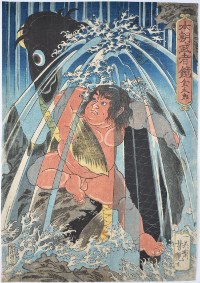
Click here to view image full size.
The young Kintaro, aka, Kintoki, Sakata Kaidomaru. He is shown fighting a giant carp in a waterfall from a series: Honcho musha kagami, Kintaro, “ Mirror of Warriors of Our Country, Kintaro.” This child of superhuman strength is often depicted with the animals living on Ashigara mountain where he honed his fighting skills and was spotted by Minamoto Yorimitsu (944-1021), under whom he went on to serve.Yoshitsuya was a pupil of Kuniyoshi and this print can be compared to a famous design by Kuniyoshi of the same subject published in 1836. Published by Tsujiokaya Bunsuke, 7/1856.
Very good impression and colour. Slight creasing, otherwise good condition. Signed Ichieisai Yoshitsuya ga.
Status: Sold
Ichieisai YOSHITSUYA (1822-1866)
Click here to view image full size.
An extremely rare print by this pupil of Kuniyoshi: Nobori ryu; kudari ryu, “Dragon going up [in the sky]; dragon going down [to the earth].” The most popular of Japanese subjects, printed in sumi and red. Published by Shimizuya Tsunejiro, 1849-50. This is the first time I have I catalogued this design.
Very good impression and colour. Minor creasing and slight adhesive mark at right edge. Signed Ichieisai Yoshitsuya ga.
Status: Sold
Utagawa KUNIYOSHI (1797-1861)
Click here to view image full size.
A bust portrait of Teranishi Kanshin holding a fan from the series Kuniyoshi moyo shofuda tsuketari genkin otoko, “ Men of Ready Money with True Labels Attached, Kuniyoshi Fashion.” The title derived from a contemporary kabuki play Shofuda tsuki kongen kusazuri. Poem above by Gosonoya of Ise. Robinson S40.7. Published by Ibaya Kyubei, 1845.
Fine impression and colour. Slight trimming and retains original album backing, otherwise fine condition. Signed Ichiyusai Kuniyoshi ga.
Status: Sold
Utagawa YOSHIHARU (1828-1888)
Click here to view image full size.
The brigand Rori Hakucho Chojun from the set Suikoden goketsu kagami, “Mirror of the Heroes of the Suikoden.” A set mirrored on Kuniyoshi’s earlier Suikoden set. Shows him, with heavily tattooed torso and wielding a sword, defending himself against a dragon. Published by Yamaguchiya Tobei, 1856.
Fine impression and colour. Slight trimming top and bottom, otherwise very good condition. Signed Ichibaisai Yoshiharu ga.
Status: Sold
Ichiyusai HIROSHIGE II (1829-1869)
Click here to view image full size.
Zojo-ji asagiri, “Morning Mist at Zojo Temple” from Toto sanjurokkei, “Thirty-six Views of the Eastern [ Edo ] Capital.” A couple watch a fish porter passing in the precincts of the Buddhist shrine . Situated in Shiba it was the Tokugawa family temple. The set published by Ai-To between 1861 and 1862 ( this being 6/1862 ). One of the six best designs from the set.
Fine impression of the first edition. Fine colour and condition. Signed Hiroshige ga.
Status: Sold
